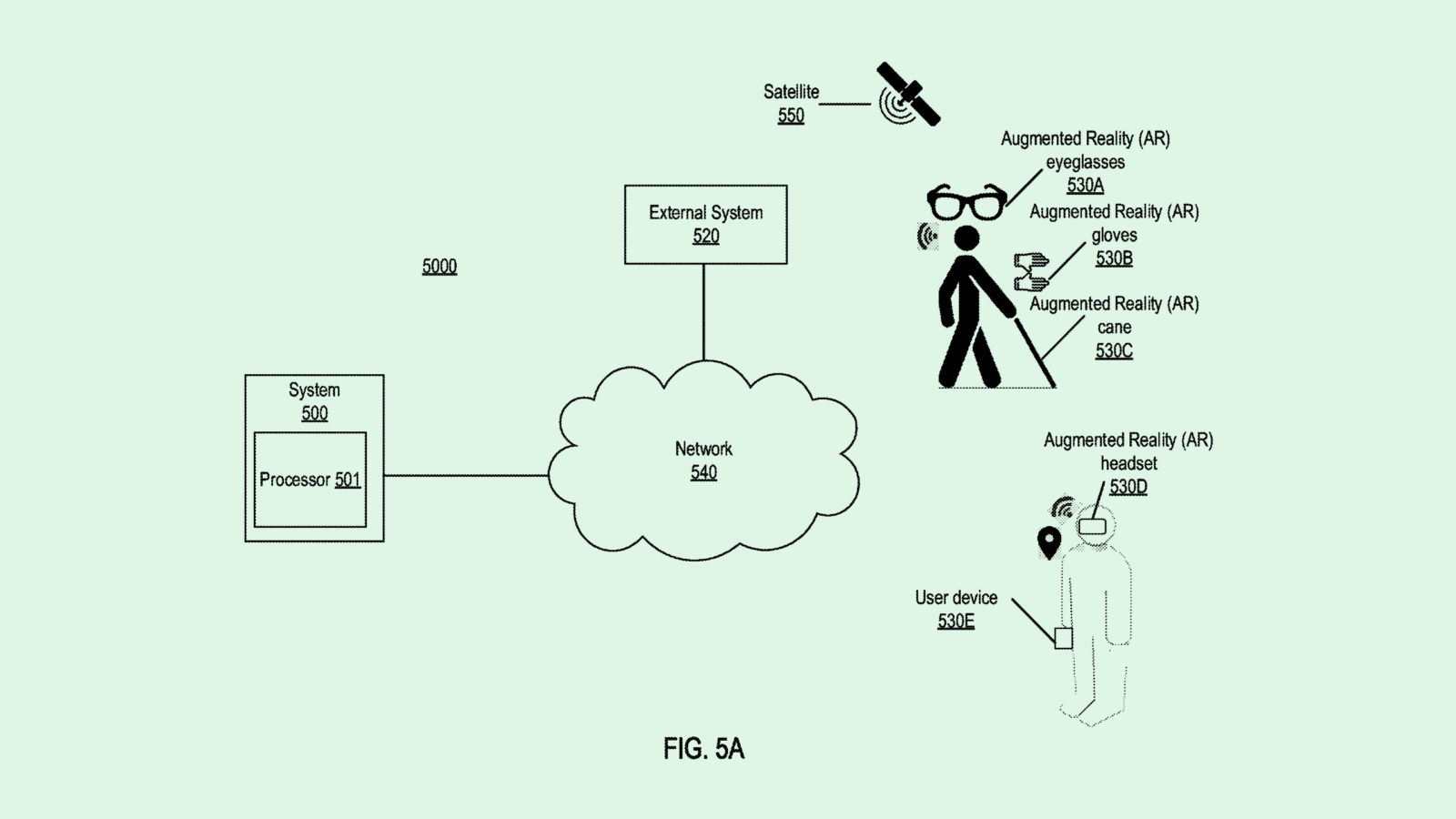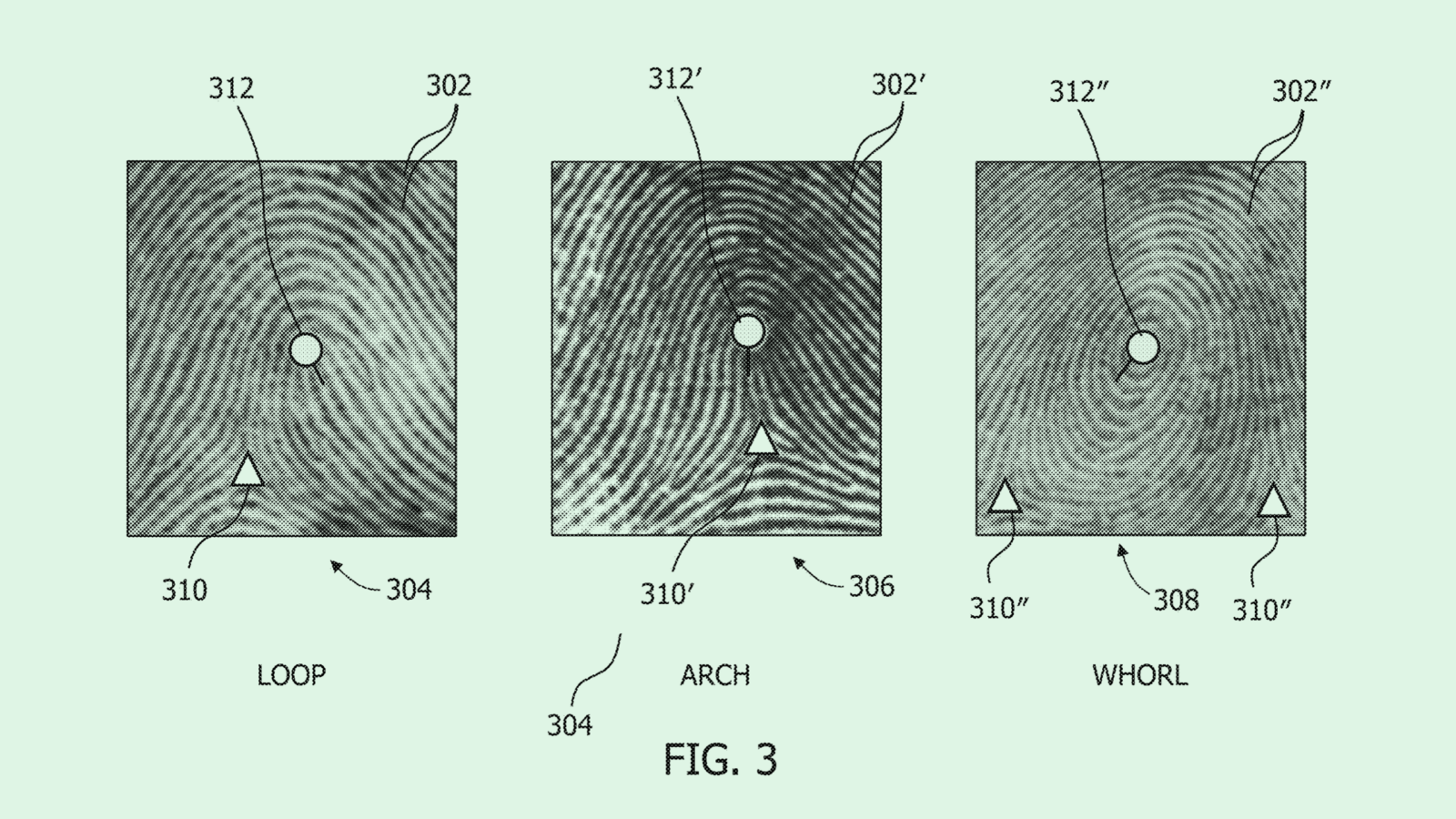Happy Monday and welcome to Patent Drop!
Today, Meta’s recent patent aims to guide people with sensory impairments using an “artificial intelligence agent” — but viable and long-lasting smart glasses may be difficult to achieve. Plus: Disney’s robotics patent puts AI to the wayside, and Mastercard wants to prevent biometric hacking.
Let’s jump into it.
Meta’s AI/AR Guide
Meta wants its smart glasses to be for more than entertainment.
The company is seeking to patent a system for “supplementing user perception” using machine learning, augmented reality and an “artificial intelligence agent.” Meta’s tech aims to provide visual, auditory and “tactile” aids in a smart glasses’ display for people with “sensory impairments.”
First, this system takes in data related to a user’s location, context, and setting to determine the relationships between the objects in the environment. Along with cameras and microphones affixed to the glasses, this system may collect data from a built-in accelerometer, and potentially gesture and haptic information “located on a walking cane or prosthesis,” or through a pair of gloves.
That data is then synthesized and analyzed by AI and machine learning algorithms, including performing localization and mapping analysis and image analysis, to determine risks associated with different locations or objects.
If the system determines a risk, such as a speeding vehicle or an alarm sounding nearby, the glasses would translate that. For example, if the user is visually impaired, it may output audio or tactile signals. If a user is hard of hearing, the system may provide visual signals to warn of a sound or something that may not be in their field of view.
“As a result, these techniques may provide various outputs, such as enabling users to read signs, appreciate depth and perspective, and identify objects associated with a context or setting,” Meta said in the filing.

With this patent in particular, focusing on helping those with sensory impairments may be a means to an end, said DJ Smith, co-founder and chief creative officer at The Glimpse Group.
Similar to Neuralink’s playbook (targeting its tech toward people with disabilities as a means of eventually reaching a broader audience), the wide scope of Meta’s patent may be angled toward a “bionic” future, he said. “This patent is trying to capture all of that — using technology to sense their surroundings and then inform the user of that information.”
However, another use case for context-aware smart glasses could be native advertising, said Jake Maymar, AI strategist at Glimpse. As it stands, Meta makes the bulk of its money from digital advertising, so extending that to its hardware work seems like a natural step, he said. Plus, given the sheer amount of cash that Meta’s Reality Labs is bleeding — $4.5 billion in the most recent quarter alone — the company may be interested in ways to recoup some losses.
“It’s very important to be context-aware when you’re advertising a product,” said Maymar. “You want to know where the person is, what they’re looking at, and what they’re interacting with.”
This tech seems like an extension of its current smart glasses offering in partnership with Ray-Ban, which includes an embedded AI model allowing people to ask questions about the context of their surroundings and get auditory responses. But actually getting the hardware to a point that allows for visuals isn’t going to be an easy feat, said Smith.
Because adding visuals into these devices requires so much processing power and generally sucks up battery, doing so with the current iterations of the technology isn’t entirely possible, said Smith. “They’re going to slowly incorporate the technology while maintaining a form factor that’s viable. It’ll slowly inch its way up.”
“All of the data centers, all of the processing power, all the infrastructure — that also needs time to develop,” said Smith. “It will strategically grow as the technology grows.”
Is Bad Company Culture Threatening Your Business?
A stale office environment and sour employees can be the demise of even the best business concepts.
Need a company-wide morale boost? The experts at BambooHR have compiled a comprehensive guide (with updated data for 2024) to teach you how to unite your people, boost retention, and keep your organization thriving: download their free Definitive Guide to Company Culture.
In this new and improved guide you’ll receive actionable insights like:
- Types of company culture and how they influence an organization’s ability to achieve goals (with example of positive culture)
- 8 strategic steps for creating a company culture that boosts retention and engagement
- Answers for who owns company culture (hint: it’s not just HR)!
Don’t let your business internally implode, learn how to optimize the employee experience and create an amazing culture at every level of your organization.
Disney’s Anti-AI Robot
Disney wants its robots to mime your movements.
The company filed a patent for a “robotics device” that takes control signals “based on movement data.” Disney’s tech essentially allows a robot to be commanded by the movements of others.
“Existing systems may be unable to be quickly and efficiently controlled to perform a target motion, such as a movement based on a reference animation, motion capture data, or sensor data,” Disney said in the filing.
The filing noted that this system can help transfer “rich motions,” such as that of people, animals, or animations, onto a robot. The system can also retarget motion onto “under-actuated” robots, meaning those built simpler, regardless of shape, size, or “degrees of freedom.”
Disney’s tech first collects motion data from a variety of sources, including animation sequences, human motion capture, or the movements of another robotics device. The system also maps correlations between the “target motion” for the robot and reference points on the robot itself. The robot’s control signals then communicate to the device how to mimic those movements.
Unlike practically every other robotics patent we’ve seen, Disney noted that this system specifically doesn’t use AI and machine learning for movement planning, claiming its method provides more precise and efficient control.

In tandem with the AI boom, robotics have become a hot topic. Practically every big tech firm, from Google to Amazon to Nvidia, has sought patents related to AI-based control of robotics. Disney’s own robotics unit has researched AI-powered robots, including blending amination with reinforcement learning for expressive, free-range movement.
Where Disney’s patent strays from the path, however, is that it’s going for something far simpler than what other firms are patenting, said Rhonda Dibachi, CEO of manufacturing-as-a-service platform HeyScottie. While AI has the capability to make robots more perceptive and reactive, Disney’s patent highlights that simple solutions have their benefits.
The simplicity of this method and its usage of reference point mapping make this tech applicable to “almost any type of robot,” said Dibachi, regardless of the physical configurations of the robot. And because this tech isn’t meant to learn movements or make decisions on its own, it’s far more precise, she added, as it’s simply following the leader. “I’d call this a ‘monkey see, monkey do’ patent.”
Plus, because it’s not reliant on complex and expensive AI training, this tech is also likely far cheaper to implement than any AI-based methods, she added. “You don’t need AI because the problems can be solved without AI,” said Dibachi. “With AI, you need a lot of data. You need to train it. And if you can bypass that step, it’s a lot easier.”
One thing missing from this patent that’s generally top-of-mind in robotics contexts is safety, she said, which may limit the tech’s usefulness. But while these robots may not be safe to deploy in Disney parks, she noted, they could be a great fit for animation purposes, making it easier to develop different proofs of concept. “Safety is an unanswered issue in this patent,” she said. “That kind of leads me to think that they’re looking at this for animation.”
Mastercard’s Biometric Safety Net
Mastercard wants to track your growing pains.
The credit card company filed a patent application for a method of “preventing biometric infringement.” Mastercard’s tech essentially continuously updates and refines biometric scans to ensure that the person offering them is actually the one who owns them.
“Current biometric sensors and registration processes cannot determine whether a single user is performing a biometric registration process, or more than one user is performing the registration process,” Mastercard said in the filing. “This enables any one of the registered users to perform a fraudulent activity by purporting to be any one of the other registered users.”
When someone registers their biometric information with Mastercard’s system, this tech would extract two or more “distinct elements” of that specific biometric, such as specific points on a fingerprint or key elements of a face, to create a unique biometric template.
When that biometric is collected and validated again, such as when a user is logging in, the system collects several more of these distinct elements and uses them to update the user’s biometric template. This allows Mastercard to create a robust biometric profile on its users, without having to collect several different types of physiological data for authentication.
Additionally, after it’s first collected, Mastercard’s system encrypts the user’s biometric template for an extra layer of security.

Mastercard has filed patents previously aiming to beef up its biometrics: One application that became public last year proposed a way to “normalize” biometric image samples that allows people to log in with the same biometric information on different devices.
In the age of AI-generated deepfakes, lots of companies are looking at ways to prove real from fake. Intel, Sony, and Google have sought to patent their own deepfake detection algorithms; Nvidia is working on watermarks for AI-generated content; and Meta’s authentication solution may rely on capturing a user’s skin vibration.
Given the growing sophistication of cyberattacks, patents like these make sense — especially for Mastercard. As one of the biggest credit card issuers globally, the company handles millions of transactions daily. And in the past several months, the company has bolstered its own AI-powered defenses, releasing a suite of fraud and identity protection tools called Scam Protect in April.
While biometrics are generally a stronger means of authentication than a password, they’re also a double-edged sword. The common solution to multi-factor authentication is to simply collect more biometric information. But because biometrics can be spoofed and stolen, once they’ve been compromised, they’re not necessarily easy to retrieve or eliminate.
Extra Drops
- Ford wants to keep you from creating roadkill. The automaker filed a patent application for “large animal detection and intervention” in a vehicle.
- Google wants its robots to have a strong handshake. The company is seeking to patent a “sensorized robotic gripping device.”
- Microsoft wants you to know how fast you’re going. The company filed a patent application for “visual odometry for mixed reality devices.”
What Else is New?
- OpenAI is developing a watermarking tool that can detect text written by ChatGPT with 99.9% accuracy, according to the Wall Street Journal.
- Neuralink has implanted its brain chip into a second patient. Around 400 of the 1,024 electrodes in the patient’s brain are operating.
- Groq, an AI chip startup, has raised $640 million in new funding, with backers such as Cisco and Samsung supporting the round. Its valuation is now $2.8 billion.
Patent Drop is written by Nat Rubio-Licht. You can find them on Twitter @natrubio__.
Patent Drop is a publication of The Daily Upside. For any questions or comments, feel free to contact us at patentdrop@thedailyupside.com.

